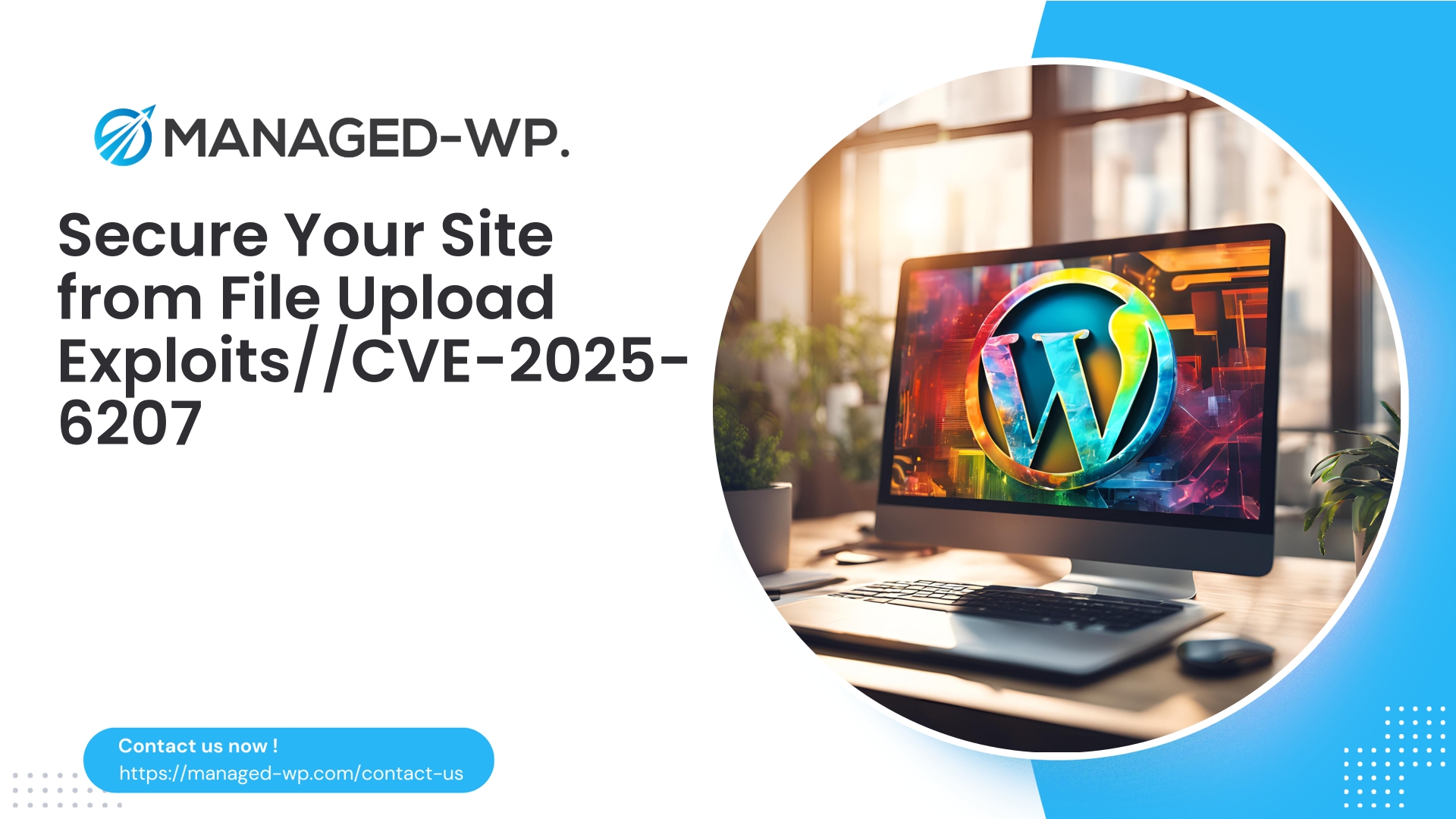
| Plugin Name | WP Import Export Lite |
|---|---|
| Type of Vulnerability | File Upload Vulnerability |
| CVE Number | CVE-2025-6207 |
| Urgency | Critical |
| CVE Publish Date | 2025-08-04 |
| Source URL | CVE-2025-6207 Details |
Critical Arbitrary File Upload Vulnerability Found in WP Import Export Lite Plugin (≤ 3.9.28) – What You Need to Know
The WordPress ecosystem thrives on plugins to extend functionality, simplify site management, and empower users to customize their sites effortlessly. However, with the power of plugins comes the responsibility to vigilantly manage their security. Recently, a high-severity vulnerability has been disclosed affecting the popular WP Import Export Lite plugin versions up to and including 3.9.28. This vulnerability allows authenticated users with as low as Subscriber privileges to perform arbitrary file uploads – a classic and dangerous security flaw that could quickly escalate into full site compromise.
As experts in WordPress security at Managed-WP, we’ll break down this vulnerability, outline the risks, and recommend the best protection measures to keep your website safe.
Understanding the Vulnerability: What Is Arbitrary File Upload?
Arbitrary file upload means an attacker can upload files of their choosing to your WordPress installation without proper restrictions or validations. The danger lies in the kind of files attackers can upload — for instance, PHP web shells, backdoors, or malicious scripts that provide unauthorized control or stealthy persistence within your environment.
Specifically for WP Import Export Lite (versions ≤ 3.9.28), this flaw is exploitable even by users with a Subscriber role — one of the lowest privilege levels in WordPress. This significantly broadens the attack surface because anyone able to log in, including newly registered or compromised subscriber accounts, can exploit this vulnerability.
How Does This Vulnerability Work?
WP Import Export Lite enables importing and exporting content such as posts, pages, and custom data. Normally, only trusted roles like Editors or Admins have these privileges, but due to inadequate permission checks and validation in the affected versions, even Subscribers can reach file upload functionality intended for higher roles.
Attackers use this loophole to upload executable files disguised as imports. Once these files are on the server, attackers can run arbitrary code, execute system commands, manipulate content, or gain full admin control over the site.
The problem originates from the plugin’s failure to properly sanitize uploads and verify the privilege level of the user performing the upload.
The Severity and Why You Should Act Immediately
- CVSS Score: 9.9 (Critical)
This near-maximum score emphasizes the vulnerability’s high impact on confidentiality, integrity, and availability. - Low Privilege Requirement
Only Subscriber-level access is needed to exploit this flaw, making it accessible to a wide pool of potential attackers. - High Risk of Widespread Exploitation
Given the popularity of this plugin and ease of attack, automated scanning and exploitation are highly likely. - Opportunistic Nature
All vulnerable sites, regardless of size or industry, are potential targets.
Real-World Impact: How Attackers Can Exploit This Vulnerability
1. Uploading a Web Shell
Attackers can upload PHP backdoors masked as import files, enabling remote shell access. This gives them the ability to:
- Browse site files and directories
- Modify or delete data
- Create or escalate user accounts
- Deploy further malware or ransomware
2. Site Takeover and Defacement
With admin privileges, attackers may change site content, deface the website, or serve phishing pages to visitors.
3. Data Theft and Compliance Risks
Sensitive customer information can be stolen, leading to data breaches and violations of privacy regulations such as GDPR.
4. SEO Poisoning and Spam Injection
Compromised websites can be used to distribute spam, malware, or malicious ads, harming SEO rankings and causing search engine blacklisting.
How to Identify If Your Site Is Vulnerable
- Are you running WP Import Export Lite version 3.9.28 or older?
- Is subscriber or low-privilege user registration enabled on your site?
- Have you detected suspicious file uploads in your
wp-content/uploads/or plugin folders? - Are there unfamiliar PHP files in directories typically reserved for media?
If you answered “yes” to any of these, your site is at significant risk and needs immediate action.
Recommended Action Plan to Secure Your WordPress Site
1. Update WP Import Export Lite Immediately
The developers have released version 3.9.29 that fixes this arbitrary file upload vulnerability. Update your plugin as soon as possible.
To update:
- Navigate to WordPress Dashboard > Plugins
- Locate WP Import Export Lite
- Click Update Now to install version 3.9.29 or newer
2. Review and Audit User Roles and Permissions
Since Subscribers can exploit this flaw, reassess user registration and privileges:
- Disable new user registrations if unnecessary (
Settings > General > Membership) - Implement stricter registration vetting or CAPTCHA
- Limit roles assigned to new users
3. Scan Your Site for Malicious Files
Use trusted malware scanners and manually audit upload and plugin directories for suspicious files or backdoors.
4. Implement a Web Application Firewall (WAF)
A WAF can block exploit attempts in real time, providing an essential security layer against file upload attacks and known exploits.
5. Harden File Permissions
Ensure restrictive file and folder permissions to prevent unauthorized file modifications or uploads.
Why Vulnerabilities Like This Keep Emerging
WordPress plugins come from a range of developers—from professionals to hobbyists—leading to variable security standards.
Common issues include:
- Inadequate permission checks
- Poor input validation and sanitization
- Assuming user trustworthiness
- Slow response to patch releases or user delays updating
This highlights the critical need for proactive security and ongoing vigilance.
Best Practices to Protect Your WordPress Site Beyond This Vulnerability
Regular Backups
Maintain frequent backups to enable quick recovery from any compromise.
Least Privilege Principle
Assign users only the minimum required permissions.
Two-Factor Authentication (2FA)
Enforce 2FA especially for admin and privileged accounts.
Monitoring and Logging
Keep an eye on login attempts, file changes, and user activities for suspicious behavior.
Keep WordPress Core, Themes, and Plugins Updated
Promptly apply updates to fix security flaws as they are discovered.
Understanding the Broader Context: Injection Flaws and OWASP Top 10
This vulnerability is categorized under the “A1: Injection” threat in the OWASP Top 10, which includes the most critical security risks for web applications. Injection vulnerabilities allow untrusted input to affect program execution, enabling unauthorized commands or data breaches.
An arbitrary file upload is basically a remote code injection vector, making it one of the most dangerous flaws.
What To Do If You Suspect Your Site Has Been Compromised
- Immediately isolate the website if feasible
- Contact your hosting provider for server-level malware scans
- Engage professional incident response for thorough cleanup
- Reset all admin passwords and revoke access of suspicious accounts
- Review access logs to determine attack vectors
Do not rely solely on plugin malware scanners, as attackers often bypass or disable them.
Stay Proactive: Automated Virtual Patching and Continuous Security
Relying on patch releases alone leaves a window of exposure. Advanced defenses include:
- Virtual Patching: Real-time blocking of exploit attempts before official patches are applied
- Vulnerability Intelligence: Constant monitoring and quick countermeasures against new threats
- Comprehensive Scanning & WAFs: Combining signature and behavioral detection for broader protection
Protect Your WordPress Today with Managed-WP’s Expert Security
Security starts with knowing the risks and acting decisively. This critical vulnerability in WP Import Export Lite highlights the ongoing threats your WordPress site faces.
If you use this plugin, update immediately to version 3.9.29 or later and apply the recommended precautions above.
Start Your Journey to Safer WordPress Site Management with Managed-WP
Looking for hassle-free, professional WordPress security? Managed-WP offers free essential protection including a managed firewall, unlimited bandwidth, malware scanning, and defense against major OWASP Top 10 threats. No compromises – just reliable peace of mind.
Discover the Managed-WP Free Plan and empower your site with strong, automated defense.
Need more? Upgrade options include automatic malware removal, IP management, security reports, and virtual patching. Prevention is better than cure — your WordPress deserves nothing less.
Summary: Key Takeaways
| Aspect | Details |
|---|---|
| Vulnerable Plugin | WP Import Export Lite ≤ 3.9.28 |
| Vulnerability Type | Authenticated Subscriber Arbitrary File Upload |
| CVSS Severity | 9.9 (Critical) |
| Risk | Full site compromise through backdoor upload |
| Required Privilege for Attack | Subscriber (lowest privilege) |
| Fixed Version | 3.9.29 and later |
| Immediate Action | Update plugin; review user permissions; scan site; enable firewall |
| Broader Security Suggestions | Backups, least privilege, 2FA, monitoring, timely updates |
As WordPress site owners and administrators, staying informed and vigilant about plugin vulnerabilities is vital. Timely updates, active monitoring, and intelligent protective tools like those from Managed-WP can significantly reduce risks and keep your website secure.
Secure your digital presence today before malicious actors do.
Written by a Managed-WP WordPress Security Specialist dedicated to empowering site owners with practical knowledge and defense strategies.

















